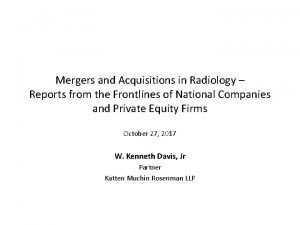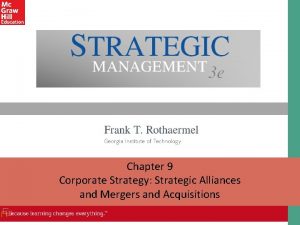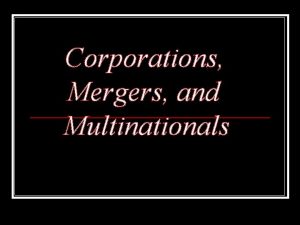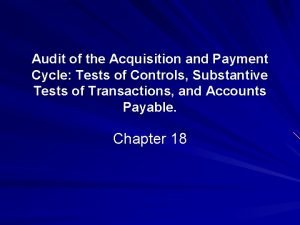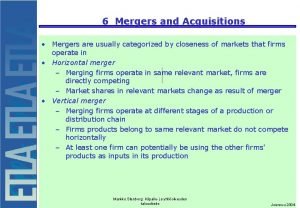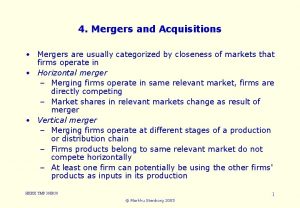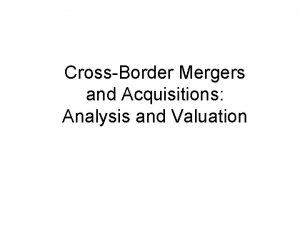Session 10 Mergers and Acquisitions C 15 0008















- Slides: 15

Session 10: Mergers and Acquisitions C 15. 0008 Corporate Finance Topics

Outline • Introduction to M&A • Valuation • Stock vs. cash acquisitions

“Market for Corporate Control” Alternative managerial teams compete to manage corporate resources (target vs. bidder/acquirer) • Proxy fights • Acquisitions

Acquisitions • Merger/consolidation (friendly takeover) – Negotiated with target managers – Approved by Boards – Voted on by shareholders – Exchange of stock • Stock acquisition (tender offer/hostile takeover) – Offer made directly to target shareholders – Cash and/or securities – Followed by merger to clean out holdouts (appraisal rights) • Asset acquisition

Classification • Horizontal acquisition: firms in the same industry, firms are competitors • Vertical acquisition: firms at different points in the production process • Conglomerate acquisition: unrelated firms

Valuation Goal: acquire a target for less than it is worth to the bidder, i. e. , undertake a positive NPV investment. Methodology: value the expected, incremental, after-tax, cash flows of the target (post merger) using DCF approaches

Important Issues • Include all incremental cash flows associated with the acquisition (10 years of projections plus terminal value? ) • Discount at a rate appropriate for the risk of the cash flows (e. g. , the target’s cost of capital) • Don’t confuse firm and equity value: V=B+S S=V-B

Value Synergistic Gains Value of target can be viewed as pre-merger market value plus value of synergistic gains. PV(gains) = t CFt / (1+r)t CF -- revenue enhancements, cost savings, tax savings r -- appropriate for (target) CF risk

Sources of Synergy • Revenue enhancement – Marketing gains – Strategic benefits – Market (monopoly) power • Cost reduction – Economies of scale – Complementary resources (e. g. , excess capacity) – Elimination of bad management • Tax gains – Increased debt capacity

Cash vs. Stock Offers Given a value for the target, the acquirer’s NPV in a cash offer is obvious: NPV = target value - cash paid When the acquisition takes the form of an exchange of stock, the NPV is harder to determine because target shareholders end up owning part of the merged firm.

Long-Run Performance 5 -year performance after mergers (All mergers from 1980 to 2002) Hostile/cash Cash All Stock 61. 7% 18. 5% -6. 5% -24. 2% • Cash deals and hostile deals outperform • Results need to be interpreted with caution

Takeover Defenses There are two possible reasons for the use of takeover defenses: (1) Target management opposition is an effort to maximize the price at which they are bought (2) Managers are only interested in preserving their jobs

Tactics Requiring Shareholder Approval • Super-majority (fair price) amendments -3% stock price reaction • Dual class recapitalizations • Change in state of incorporation • Change in voting procedure for Board (e. g. , staggered elections) -1% stock price reaction

Tactics Not Requiring Shareholder Approval • Targeted share repurchase (greenmail) – May be accompanied by standstill agreement – Negative share price reaction • Poison pills – Shareholder rights agreement – Negative but small reaction • State anti-takeover amendments

Conclusions • It is difficult to fight off a takeover forever (in the end shareholders make the decision) • Bidding wars appear to maximize takeover premiums • Target managers may end up with compensation (golden parachutes)
 Radiology mergers and acquisitions
Radiology mergers and acquisitions Hr issues in mergers and acquisitions
Hr issues in mergers and acquisitions Franchise mergers and acquisitions
Franchise mergers and acquisitions Define corporate restructuring
Define corporate restructuring Mergers and acquisitions in strategic management
Mergers and acquisitions in strategic management Mergers and acquisitions rumors
Mergers and acquisitions rumors Vertical complementary strategic alliance
Vertical complementary strategic alliance What is merger and consolidation
What is merger and consolidation Forbes mergers & acquisitions
Forbes mergers & acquisitions 0008 country code
0008 country code Ieee sa
Ieee sa Corporations mergers and multinationals
Corporations mergers and multinationals New evidence and perspectives on mergers
New evidence and perspectives on mergers Mergers and takeovers tutor2u
Mergers and takeovers tutor2u Purchase and payment cycle
Purchase and payment cycle Audit of capital acquisition and repayment cycle pdf
Audit of capital acquisition and repayment cycle pdf
